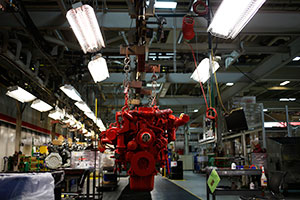EPA Seen Siding With Engine Makers in Truck-Efficiency Rules

The Obama administration is poised to deliver a victory to engine makers at the expense of truck manufacturers in the next stage of the U.S. government’s plan to tackle climate change.
The Environmental Protection Agency is about to propose fuel-economy standards that would mandate efficiency gains in engines and transmissions made by companies such as Cummins Inc. and Eaton Corp., according to executives who have been in discussions with the regulator.
That will encourage the development of new technology and the replacement of engines.
“It’s a huge deal,” said Mihai Dorobantu, Eaton’s director of technology planning and government affairs. “It’s an opportunity for advanced technology to contribute both to the economics of the sector and the environment in which we all live.”
Truck makers had pushed for eliminating the engine target and just testing the whole vehicle the way automobiles are assessed. That way, fuel-consumption targets could be met with less expensive changes, such as improved aerodynamics.
“An overly stringent engine standard could force the introduction of technologies and design changes prematurely, resulting in added costs, weight, vehicle complexity and, ultimately, potentially delaying customer adoption,” said Steve Barry, director of regulatory affairs for Volvo AB’s North American truck unit.
Environmental groups are pushing President Obama to deliver fuel-economy improvements of 40% from 2010 levels, something they say is technologically feasible and long overdue because tractor-trailers average 6 mpg of diesel. That change alone could cut U.S. oil use by 1.4 million barrels a day and eliminate more than twice the greenhouse gases as New Jersey emits each year, according to the Sierra Club.
EPA spokeswoman Liz Purchia declined to comment ahead of the release of the trucking proposal, which industry representatives said they expect this month. The Obama administration will then accept public comment before issuing a final regulation next year.
One of the key decisions for EPA and the National Highway Traffic Safety Administration is how to measure gains from the engine and the overall vehicle. Under the proposal nearing release, engines will be tested the same way emissions are measured. Vehicles will be measured by using a computer model instead of the dynamometers used to test cars.
That approach also is supported by Cummins, said Brian Mormino, the company’s executive director for worldwide environmental strategy and compliance.
EPA also will be proposing a third set of standards for trailers, whose boxy design has largely been unchanged for decades.
Trucks account for 4% of vehicles on the road and 20% of the transport sector’s carbon emissions. Setting tougher rules is necessary if the United States will achieve the cuts in carbon emissions Obama pledged in United Nations climate negotiations, the World Resources Institute said in a report last month.
“This is a very significant segment of our economy that needs to come under the climate plan the president is putting together,” said Margo Oge, former director of EPA’s office of transportation and air quality. “It’s a big deal to have a standard that pushes innovation and reins in fuel consumption.”
Daimler Trucks North America has warned regulators against engine standards that aren’t aligned with real-world operations, Sean Waters, director of product compliance and regulatory affairs, said in a statement.
The company, which makes Freightliner trucks, still is “optimistic the final rule will be consistent with our goals of providing real-world fuel-economy benefits that reduce the real cost of ownership for our customers,” Waters said.
The rules will represent the second time in history that U.S. regulators will propose efficiency standards for the more than 7 million tractor trailers and other kinds of heavy-duty trucks that haul most of the nation’s goods.
Waste Management Inc., which has a fleet of 18,500 garbage and collection vehicles, is part of a group of companies helping EPA develop the standards. Most of the new trucks the company is buying run on natural gas, which cuts greenhouse-gas emissions by 20% over diesel, said Kerry Kelly, senior director for federal affairs.
“It’s been a good process so far, and so we feel that we’ll get to a reasonable rule we can support,” Kelly said.




